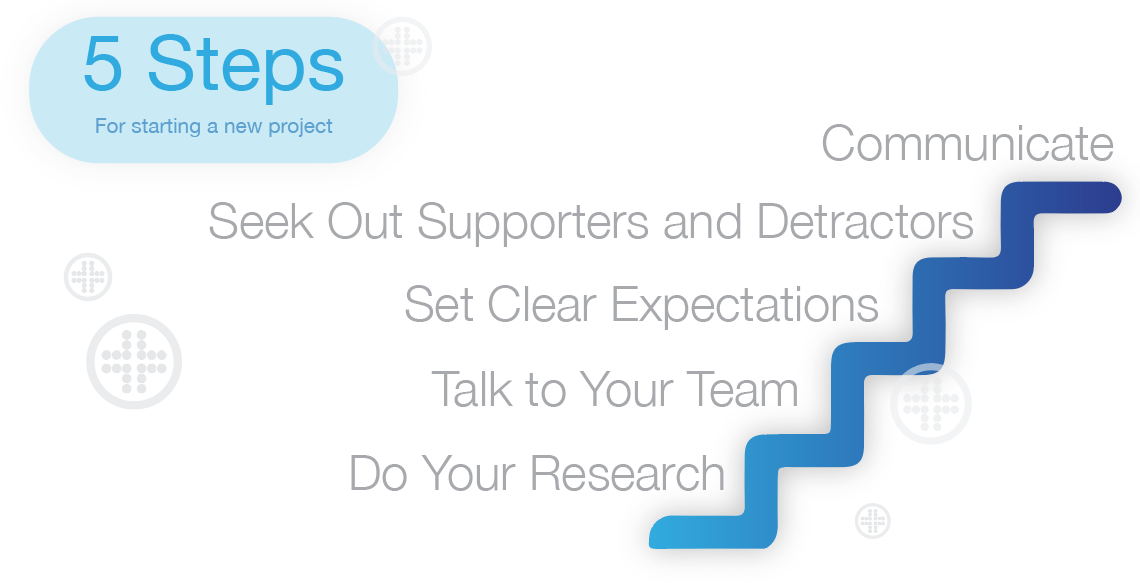Healthcare CIOs: 5 Easy Ways to Keep Weeds Out of Your Projects

 John Mason, SVP of Strategic Operations of The HCI Group, shares his thoughts on how hospital CIOs can set good expectations and reduce the frustration level of team members when working on a new project or implementing new technology. John has more than three decades of leadership experience and is the former CIO of Hill County Memorial in Fredericksburg, Texas and former CIO of St. David’s Healthcare in Austin, Texas.
John Mason, SVP of Strategic Operations of The HCI Group, shares his thoughts on how hospital CIOs can set good expectations and reduce the frustration level of team members when working on a new project or implementing new technology. John has more than three decades of leadership experience and is the former CIO of Hill County Memorial in Fredericksburg, Texas and former CIO of St. David’s Healthcare in Austin, Texas.
Years ago, I decided that I needed to make sure my yard looked as good as my neighbor’s. You likely know my neighbor because you probably have one too…the one you drive by and think “how much time do they have on their hands”, or “they must have a real ‘green thumb’ to have a yard that nice.” For whatever reason, whether it was internal guilt, or the comments by my friends about that ’nice yard down the street’, I decided I had to do something.
Just about that time, one of the national lawn company salesmen happened to drop by my house, and I figured this was my chance to be the envy of the neighborhood. I imagined a perfectly manicured lawn, soft as cotton and a beautiful shade of green out front, with neighbors driving by on a Sunday just to have a look! And, of course, the salesman made sure I imagined it that way with his slick brochures and knowledge of every weed growing in my yard.
Before I knew it, I was signed up, and they were going to start treatments right away. In a few months, my yard would be the envy of every golf course in the area (just look at any of their web sites and you’ll see what I mean!).
But it didn’t take long for my expectations and experience to start to diverge. Sure, the first visit with a ‘Yard Specialist” was interesting, and he spent a great deal of time spraying my yard, talking with me about what I had growing and educating me on how his various treatments were going to turn my disaster around. But then, things started to change.
It started out with a couple of months of visits at times when we weren’t home. No big deal, but I noticed that my lawn didn’t seem to be changing. The weeds were still there. The ‘flowers’ were as beautiful as ever, and actually seemed to be flourishing. I called the office and asked that they be sure we were home before they treated any more, and they assured me things were being done, but they understood, and would tell the specialist to only treat when we were home.
Apparently, the specialist didn’t get the word. Several more treatments happened while we were away, evidenced by the receipt on the front door telling us they were sorry they missed us, but the treatment went well. I called again. Again, the office assured me they would let the driver know and apologized for the miscommunication. This wouldn’t happen again. All the while, the yard continued to look just the same, if not worse.
Then, the final straw. It was a weekday, and I had taken the day off to take care of a few things around the house that needed addressing. I was home all day, in and out of the garage and the yard, and never saw the big green truck. But, a little later, I went out the front door, and there was a receipt for a treatment. The card said they were sorry they missed us, but the treatment went well! Really!? The yard wasn’t even wet, and surely I would have seen the truck out front, or the specialist walking around the yard with his big hose.
That was when it ended. I called the office, told them what happened and promptly cancelled my contract. Of course, they did everything they could to get me to change my mind, but their lack of results from the previous calls told me this wasn’t going to get any better. The number of calls from sales folks, and attention to my situation suddenly changed. Turns out they had had some ‘issues’ with that specialist (it must have been him, and couldn’t be the company) and would I renew if they assigned another driver? The answer was an unequivocal no. They had gone into negative numbers with me.
You see, frustration is a measurable feeling. In fact, there is a formula for frustration that’s very simple if you know what the variables are. Here is the formula:

Let’s do the math on my experience.
Remember, I had high expectations, both self-generated, and supported by the salesman who dropped by with his fancy brochures. Assuming the best anyone could do is 100 (any number you assign will work as long as you are consistent), we have the first part of the equation.
F=R-100
(My expectations were 100)
Now, if they had fully met my expectations, and my yard quickly became the stuff of legends, they could have received a 100 in results as well. If that had happened, here’s the Frustration Factor:
F=100-100
F=0
(I would have had zero frustration)
A perfect score. Zero frustration and 100 percent happiness! Who could ask for more?
But, as you can guess from this article, the results weren’t as advertised.
In reflection, I might have set my expectations a bit lower (or maybe the sales rep should have when he looked at my yard) and that would have made the situation a bit better. But, it was set at 100, so here’s what my actual formula turned out to be:
F=R-E
F=25-100
F=-75
(I’m being generous giving them a 25% on this one)
You see, any frustration level with a negative number is bad, and a minus 75 is certainly not a good result.
Now, you might be asking yourself if it’s possible to ever hit a perfect 0. The answer is yes. In fact, in this case, they could have met my expectations (a perfectly green yard, free of weeds that looked like a signature golf course) and I would have been able to give them 100 and my frustration would have been 0. Or, in this case, they could have exceeded my expectations and made my yard look like The Masters and I could have given them more than 100…bonus points. But, sadly it wasn’t so.
So, what’s the lesson for us in our work as a CIO of a hospital?
Hospital CIOs Must Manage Expectations
As a CIO, one of the most important parts of your job is managing expectations of your customers. The folks doing the real work of making the systems operate count on you to do your part to make sure you let the customer know what to expect, and head them off when they start expecting perfection.
Mind you, this doesn’t mean you need to be a Negative Nelly, and always try to undershoot the capabilities of your team, but neither should you be a Pollyanna, not being willing to be realistic about what might happen. It’s a fine line, and it takes some practice.
As a CIO, your job is to know your team, know the capabilities of the technology and processes, and be able to accurately assess and translate that capability into a reasonable expectation of results.
As I said, this comes with experience and practice. In your first few months on the job, it’s hard to know what your team can, and can’t, deliver on. If it’s a new technology, it’s hard to know if the system is proven enough to estimate the results. And with customers, it can be hard to know what they are really expecting, and what they are telling you they expect.
5 Steps to Consider When Starting a New Project or Technology
But, there are a few ways to help set good expectations, and reduce the frustration level of your customers. Here are a few steps to consider as you start out on a new project or technology.

1. Do Your Research
In hindsight, I should have looked around my neighborhood and noticed that no one had a yard that looked like the Masters! My neighbor down the street with the yard worth envy still wasn’t living on a golf course. His yard was nice, but not THAT nice. The same goes for new technologies and systems. Do your research ahead of time, and make sure you’ve talked to enough people to understand what is and isn’t realistic. Ask them what they expected, and what their actual Frustration Factor turned out to be. Knowing that up front goes a long way to making sure you set expectations clearly. Don’t just take the word of the sales person with the slick brochure….she/he has a vested interest in helping you see things with rose colored glasses.
2. Talk to Your Team
I’ve learned this lesson the hard way. Setting expectations with the customer without talking to your team and understanding what’s reality. They’ve likely got a lot more experience with whatever you’re about to undertake than you do. And if not, they can still give you some good advice and will know what the customers have typically expected in the past. The team is key to your success…don’t make the mistake of forgetting them. In the case of my yard, I would be willing to bet that the sales rep had no experience with a home once the contract was signed. He didn’t know how things ultimately turn out for customers, and so wasn’t able to effectively set expectations when he sold the next contract.
3. Set Clear Expectations – In Writing
One of the worst mistakes you can make when trying to set expectations is to assume that conversations alone are enough to help the message sink in and set good predictions with your customers. Research published by Albert Mehrabian, often disputed, says that 7% of what you say to a customer influences them. The other 93% come from body language, tone and demeanor, said Mehrabian in his book Silent Message. Even if the actual percentages are disputable, my experience tells me that a large portion of what you tell someone will be misunderstood, misinterpreted, or just missed altogether. As you deal with large, complex projects that require that everyone be on the same page, putting things in writing in very clear language is critical. Without it, you are sure to miss expectations and have high Frustration Factors.
4. Seek Out Supporters and Detractors
Most folks hate to be around people that don’t support them. It’s just human nature. We seek out people that are more like us, tend to support our views and ideas, and will help us succeed in our work. People who don’t do that tend to rub us the wrong way, and human nature tells us we’re better off avoiding them. But, your detractors can often-times become your biggest advocates once you win them over. If not, you will gain some great insight into potential problems and pitfalls that you’ll encounter.
5. Communicate, Communicate, Communicate
Once you’ve set expectations with your customers, you can’t assume that they’ll remember what you told them, nor will they pull out the document you wrote on a regular basis just to see what a great job you’ve done hitting their expectations. Expectations are an internal phenomenon, and communication is the best way to stay plugged into the internal feelings and concerns of your customers. An example of how expectations are an internal feeling can be explained by the idea of ‘phantom limbs.’ When someone experiences the loss of a limb, they will often describe the sensation that the limb is still attached to them. In fact, it’s not uncommon for someone to feel the need to scratch an itch on the missing limb, or have feelings of pain and heaviness where the limb used to be, despite the fact that they can see the limb is no longer there. Much like phantom limbs, expectations drive our feelings, even in the face of reality. If your customer expects a project to be going well, and isn’t feeling like it is meeting their expectations, no amount of logical, factual data will change their mind. You can only change their mind by subtly, and consistently ‘guiding’ those expectations through consistent communication.
No one likes to be frustrated. And as a CIO, the last thing you want is a frustrated customer who views technology as over promising and under delivering. It’s incumbent on you, the CIO, to help set those expectations early, often and ongoing if you want the team, and the organization to be a success.
